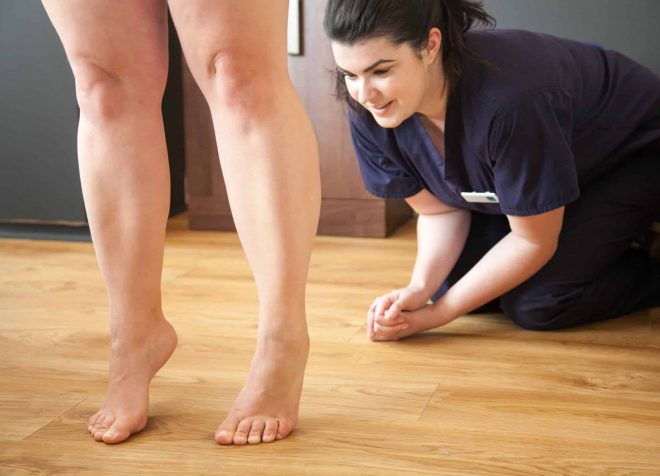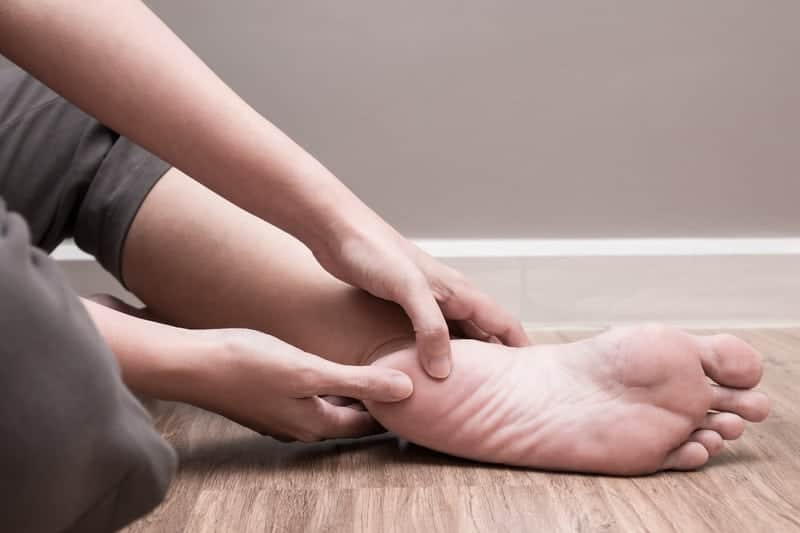Heel Pain
Heel pain is a common condition that affects individuals of all ages and activity levels. Heel pain occurs due to a variety of factors, including overuse, injury, or certain medical conditions. The most common cause of heel pain is plantar fasciitis, which is inflammation of the plantar fascia, a thick band of tissue that runs along the bottom of the foot from the heel to the toes. Other causes of heel pain include Achilles tendonitis, stress fractures, heel spurs, and bursitis.

What are the Common Causes of Heel Pain?
- Plantar fasciitis is the most common cause of heel pain and affects millions of people each year. It typically develops gradually over time and is often caused by repetitive stress to the plantar fascia. This can be due to activities such as running, jumping, or standing for long periods of time. Individuals who are overweight or have flat feet are also at an increased risk of developing plantar fasciitis. Symptoms of plantar fasciitis include pain and stiffness in the heel or arch of the foot, especially when first getting out of bed in the morning or after prolonged periods of sitting. The pain may also worsen with activity and improve with rest. Treatment for plantar fasciitis typically involves a combination of stretching exercises, orthotics,and anti-inflammatory medication. In severe cases, corticosteroid injections or surgery may be necessary.
- Achilles tendonitis is another common cause of heel pain, which is caused by inflammation of the Achilles tendon. This tendon connects the calf muscles to the heel bone and is essential for walking, running, and jumping. Achilles tendonitis is often caused by overuse or a sudden increase in activity level, such as starting a new exercise routine. Symptoms of Achilles tendonitis include pain and stiffness in the back of the heel, which may worsen with activity or prolonged periods of standing. Treatment typically involves rest, stretching exercises, and anti-inflammatory medication. In severe cases, physical therapy or surgery may be necessary.
- Stress fractures can also cause heel pain, especially in athletes or individuals who engage in high-impact activities such as running or jumping. A stress fracture is a small crack in the bone that can develop over time due to repetitive stress. Symptoms of a stress fracture include pain and swelling in the affected area, which may worsen with activity and improve with rest. Treatment typically involves rest, immobilisation of the affected area, and pain management.
- Heel spurs are bony growths that develop on the heel bone and can cause pain and discomfort. They are often associated with plantar fasciitis and can be caused by repetitive stress to the heel. Treatment for heel spurs typically involves a combination of stretching exercises, orthotics, and anti-inflammatory medication. In severe cases, surgery may be necessary.
- Bursitis is inflammation of the bursa, a small sac of fluid that cushions and lubricates joints. In the heel, bursitis can develop between the Achilles tendon and the heel bone or between the skin and the heel bone. Symptoms of bursitis include pain and swelling in the affected area, which may worsen with activity or pressure. Treatment typically involves rest, ice, compression, and elevation of the affected area, as well as anti-inflammatory medication.
Whether heel pain will go away or not depends on the underlying cause of the pain. In many cases, heel pain can be relieved with rest, stretching, and over-the-counter pain medication. However, if the pain is caused by a more serious condition such as a stress fracture or a ruptured Achilles tendon, it may require more aggressive treatment and a longer recovery period.
If heel pain is left untreated or ignored, it can become a chronic condition and affect your ability to perform daily activities. It can also lead to other foot and leg problems such as knee and hip pain, as well as changes in your gait.
In rare cases, heel pain can be a sign of a more serious medical condition, such as a tumour or infection. If your heel pain is accompanied by redness, warmth, or fever, it is important to seek medical attention immediately.
In general, it is important to address heel pain promptly and seek medical attention if it persists or worsens over time. Early treatment can prevent the condition from becoming chronic and improve your chances of a full recovery.

Preventing heel pain involves taking steps to reduce your risk of injury and overuse. This includes wearing supportive shoes with good arch support and cushioning, warming up before exercise, and gradually increasing the intensity and duration of physical activity. It is also important to maintain a healthy weight and to stretch regularly, especially the calf muscles and plantar fascia.
Orthotics can be helpful in managing the symptoms of plantar fasciitis by providing support and cushioning to the foot. Here are some of the best types of orthotics for plantar fasciitis:- Custom-made orthotics: Custom-made orthotics are designed to fit the specific shape and size of your foot, providing maximum support and comfort. They are typically more expensive than other types of orthotics, but they are often the most effective.
- Prefabricated orthotics: Prefabricated orthotics are less expensive than custom-made orthotics, but they still provide good support and cushioning. They come in a variety of sizes and shapes, so it’s important to find one that fits your foot well.
- Heel cups: Heel cups are small inserts that fit into the heel of your shoe. They provide extra cushioning and support to the heel, which can help alleviate pain associated with plantar fasciitis.
- Arch supports: Arch supports are inserts that provide extra support to the arch of the foot. This can help reduce the strain on the plantar fascia and alleviate pain.
- Night splints: Night splints are devices that are worn while you sleep. They help stretch the plantar fascia and Achilles tendon, which can help reduce pain and stiffness in the morning.
It’s important to note that orthotics are just one part of a comprehensive treatment plan for plantar fasciitis. You should also consider stretching exercises, rest, and ice therapy, and consult with your podiatrist to determine the best treatment plan for your individual needs.








